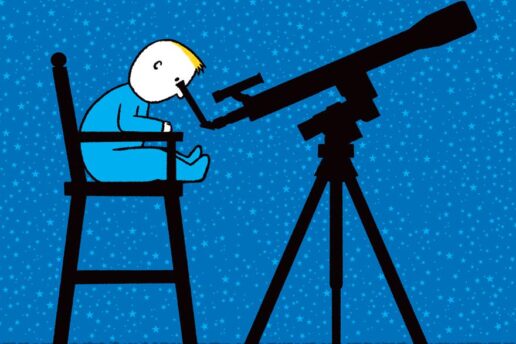
Seeing Wonder Through the Eyes of Science
Like infants exploring how the world works, scientists are driven by curiosity and awe to build a deeper picture of reality.
Recently I’ve been watching my grandson develop from a helpless infant into a functioning child. It’s inspiring and deep to see Luke learn to make sense of the world. I watched him drop spoons from his high chair over and over again, each time checking that they’d relocated to the ground. Every parent (or grandparent) has seen such comical yet deeply serious “experiments.”
Through these investigations, babies learn how to translate the jumble of photons that pass through our tiny pupils and impinge on our two-dimensional retinas into the three dimensional world of objects that we navigate in everyday life. Other babyish meditations build up our concept of self and our explanatory models of other minds inside other bodies. These are great achievements. Researchers in artificial intelligence have struggled to replicate them, with limited success.
To understand reality, it’s efficient and reasonable for children to take lessons from the way things behave in the everyday world. But our eyes can’t perceive distant galaxies or the atoms and molecules that build up matter. The electromagnetic waves that power radios and microwave ovens pass unnoticed, as do the electric flows that power our muscles and encode our thoughts. We do not have the infrared vision of snakes, the ultraviolet vision of bees, or bats’ ability to pick up ultrasound.
The physical world revealed by modern science is fundamentally different from the model we construct as babies. Scientific instruments let us perceive the world better than we can using only our bodies. We can use microscopes, telescopes, spectroscopes, magnetometers, particle accelerators, atomic clocks and other tools to explore the physical world’s reality.
Even more crucially, we can use critical reasoning to bore down to fundamentals and imagination to build them back up again. The universe is vastly large and vastly old, on human time scales. But if the world is abundant, so are we. As Walt Whitman exulted, “I contain multitudes.” Every human brain contains a galaxy’s worth of complex neurons that fire billions of times within our lifetime, creating dynamic patterns of information and thought.
If you once again open yourself up to the world, curious and without preconceptions—if you allow yourself to be born again—you will find new keys that open hidden doors. This is, of course, quite different from being “born again” in the sense of evangelical revelation. Yet it beautifully fulfills Saint Paul’s verse: “When I was a child, I spoke as a child, I understood as a child, I thought as a child; but when I became a man, I put away childish things.”
Scientific understanding does not replace the modes of thought we use in everyday life, but it can supplement and enhance them. Rainbows are more beautiful, the starry night is more awesome, and other minds are more fascinating when you view them more fully, by the light of fundamental realities they reflect. You may come, in special moments, to live out William Blake’s vision:
To see a World in a Grain of Sand
And a Heaven in a Wild Flower
Hold Infinity in the palm of your hand
And Eternity in an hour.
—Prof. Wilczek received the Nobel Prize in Physics in 2004. This column is adapted from his new book “Fundamentals: Ten Keys to Reality,” which will be published on Jan. 12 by Penguin Press.
Originally appeared on January 7, 2021 on The Wall Street Journal website as ‘Seeing Wonder Through the Eyes of Science‘
Frank Wilczek is the Herman Feshbach Professor of Physics at MIT, winner of the 2004 Nobel Prize in Physics, and author of the books Fundamentals: Ten Keys to Reality (2021), A Beautiful Question: Finding Nature’s Deep Design (2015), and The Lightness of Being: Mass, Ether, and the Unification of Forces (2009).